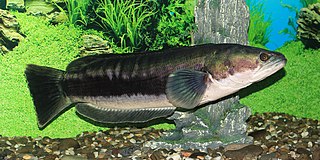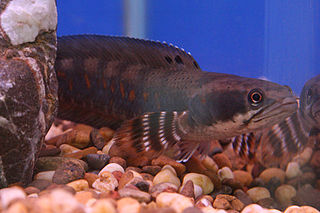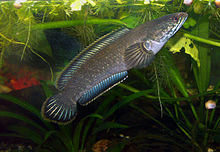
The northern snakehead is a species of snakehead fish native to temperate East Asia, in China, Russia, North Korea, and South Korea. Their natural range goes from the Amur River watershed in Siberia and Manchuria down to Hainan. It is an important food fish and one of the most cultivated in its native region, with an estimated 500 short tons (450 t) produced every year in China and Korea alone. Due to this, the northern snakehead has been exported throughout the world and has managed to establish non-native populations in Central Asia and North America. In the United States, it is found in Pennsylvania, Virginia, West Virginia, Delaware, Maryland, North Carolina, Arkansas and Mississippi.

Channa is a genus of predatory fish in the family Channidae, commonly known as snakeheads, native to freshwater habitats in Asia. This genus contains about 50 scientifically described species. The genus has a wide natural distribution extending from Iraq in the west, to Indonesia and China in the east, and parts of Siberia in the Far East. A particularly high richness of species exists in Myanmar (Burma) and northeastern India, and many Channa species live nowhere else. In contrast, a few widespread species have been introduced to several regions outside their natural range, where they often become invasive. The large and medium-sized Channa species are among the most common staple food fish in several Asian countries, and they are extensively cultured. Apart from their importance as a food fish, snakeheads are consumed in some regions as a traditional medicine for wound healing and reducing postoperative pain and discomfort, and collected for the international aquarium pet trade.

The snakeheads are members of the freshwater perciform fish family Channidae, native to parts of Africa and Asia. These elongated, predatory fish are distinguished by their long dorsal fins, large mouths, and shiny teeth. They breathe air with gills, which allows them to migrate short distances over land. They have suprabranchial organs, which are primitive forms of labyrinth organs, that develop when they grow older. The two extant genera are Channa in Asia and Parachanna in Africa, consisting of more than 50 species.

Channa bleheri is a species of dwarf snakehead that is endemic to the Brahmaputra River basin in the Indian states of Assam and Arunachal Pradesh. It is among the most colorful species of snakehead.

Dwarf snakehead is a term coined by aquarists to describe a group of Channa snakehead fishes growing to about 25 cm (10 in) maximum. They are found in freshwater habitats in South and Southeast Asia, and southern China.

The forest snakehead is a species of snakehead, a fish of the family Channidae. Its range includes most of Southeast Asia and parts of southern China. It lives in forest streams and can reach 40 cm (16 in) in length. The forest snakehead is known in Thai language as pla krasong. Khmer language called it កញ្ជនជៃ, Indonesians named it kehung, while in Malaysia, they called it ikan bujuk in Malay Language and in Vietnamese its name is cá lóc dày

Channa striata, the striped snakehead, is a species of snakehead fish. It is also known as the common snakehead, chevron snakehead, or snakehead murrel and generally referred simply as mudfish. It is native to South and Southeast Asia, and has been introduced to some Pacific Islands. Reports from Madagascar and Hawaii are misidentifications of C. maculata.
Channa burmanica is a species of snakehead which is endemic to northern Burma. It is a very small species of snakehead included in the informal group of dwarf snakeheads. Its colouring closely resembles that of Channa gachua and Channa bleheri. It is very rarely found in pet shops. It is also considered to be a mouthbrooder species, though no successful breeding has yet occurred.
Channa harcourtbutleri, the Burmese snakehead, is a species of snakehead endemic to Inle Lake and surroundings in Myanmar. Locally called nga ohn-ma, among aquarists it is considered one of the dwarf snakeheads, but no significant import for aquarists is known. It is one of the smaller species of snakehead and has a standard length of up to 19.4 cm (7.6 in). The specific name honors Sir Harcourt Butler, a British governor in the region.

Channa micropeltes, giant snakehead, giant mudfish or toman harimau, is among the largest species in the family Channidae, capable of growing to 1.3 m (4.3 ft) in length and a weight of 20 kg (44 lb). It is native to the fresh waters of Southeast Asia, but has also been introduced elsewhere and is considered invasive in Taiwan. Other names include shol machh in Bengali, red snakehead, redline snakehead, and ikan toman.

The Ceylon snakehead is a species of snakehead found in freshwater habitats, typically shaded streams, in southwestern Sri Lanka.

Channa marulius, the bullseye snakehead or great snakehead, is a large species of snakehead native to South Asia. Populations in Southeast Asia are now regarded as separate species.

The Anabantiformes, is an order of bony fish (Teleostei) proposed in 2009. They are collectively known as labyrinth fish, are an order of air-breathing freshwater ray-finned fish with two suborders, five families and at least 207 species. In addition, some authorities expand the order to include the suborder Nandoidei, which includes three families - the Nandidae, Badidae and Pristolepididae - that appear to be closely related to the Anabantiformes. The order, and these three related families, are part of a monophyletic clade which is a sister clade to the Ovalentaria, the other orders in the clade being Synbranchiformes, Carangiformes, Istiophoriformes and Pleuronectiformes. This clade is sometimes referred to as the Carangaria but is left unnamed and unranked in Fishes of the World. This group of fish are found in Asia and Africa, with some species introduced in United States of America.

Channa pulchra is a species of snakehead fish in the family Channidae which is native to Myanmar. It was first described in 2007 by R. Britz from a specimen collected from the Kyeintali Chaung (stream) basin in Rakhine Yoma, western Myanmar. The fish is found in streams that are fast flowing, clear, highly oxygenated and relatively cold (subtropical). It is of little food value but getting popularity as an aquarium fish recently.
Channa royi, the Andaman emerald snakehead, is a species of snakehead fish endemic to the Andaman and Nicobar Islands of India. This dwarf snakehead is distinct from other snakehead species due to its differing coloration, number of vertebrae, and teeth, most notably its greenish-gray dorsum. It was only scientifically described in 2018 and its closest relative is the Burmese snakehead, and a review in 2019 argued that the two are synonyms.

Aenigmachanna gollum, the Gollum snakehead, is a species of aquifer-dwelling dragon snakehead fish that is endemic to the Indian state of Kerala.

Channa auroflammea is a species of snakehead, a fish of the family Channidae. Its range includes Mekong River. It was previously lumped with C. marulius, C. cf. marulius, or C. aff. marulius, but can be distinguished within the group by colour pattern, other morphological characteristics, and genetic information.
Channa ornatipinnis is a freshwater species of snakehead, a fish of the family Channidae. It is found in tropical Asia. They can get up to 30.5 cm (12.0 in) long.

Channa aurolineata is a species of Asian snakehead in the family Channidae. It is found natively in most of Myanmar's waterways as well as the Mae Khlong drainage in Thailand. There is also an invasive population found in Southeast Florida, United States. This species was recently split from C. marulius, the bullseye snakehead, and confirmed as a separate species in 2018; and the Florida and Thailand populations were not discovered to be C. aurolineata until even more recently in 2019. Before this, the Thailand population's species was unknown and the Florida ones were assumed to be C. marulius. C. aurolineata was able to be separated as a new species and identified in other areas due to slight differences in color pattern, lateral line scale and fin ray morphology, and DNA structure from the other species in the marulius complex.
Channa cyanospilos, commonly known as the bluespotted snakehead, is a species of fish in the family Channidae. It has a maximum length of about 20 cm. It is usually found in clear rivers and in black water areas. It is native to parts of Malaysia and Indonesia. It is rarely traded and commonly mistaken for another species.

















